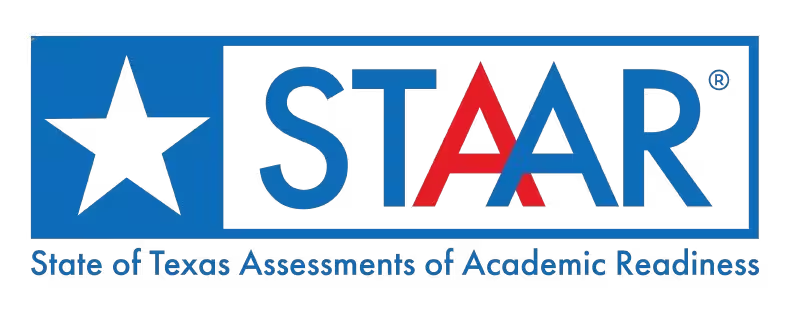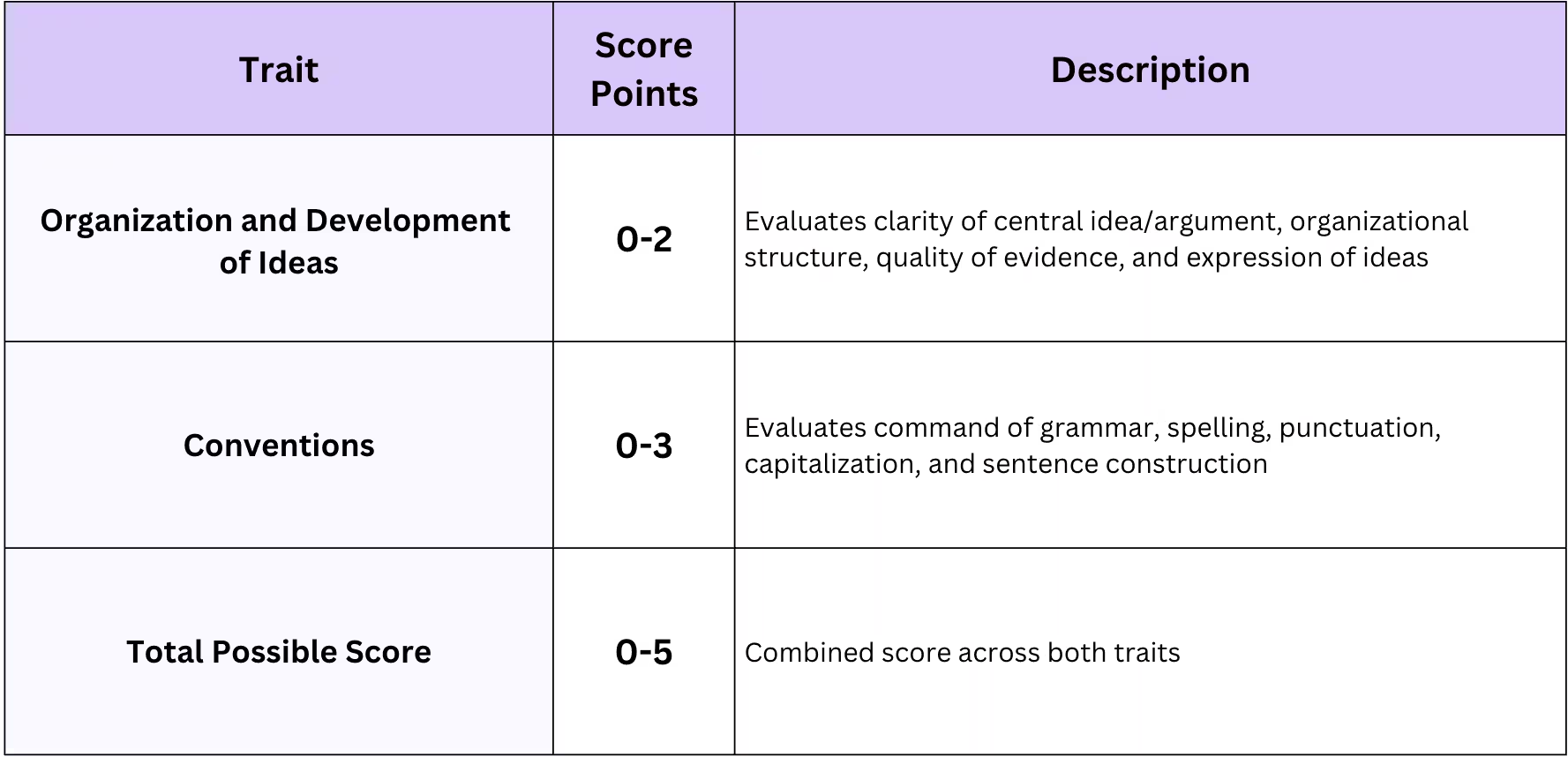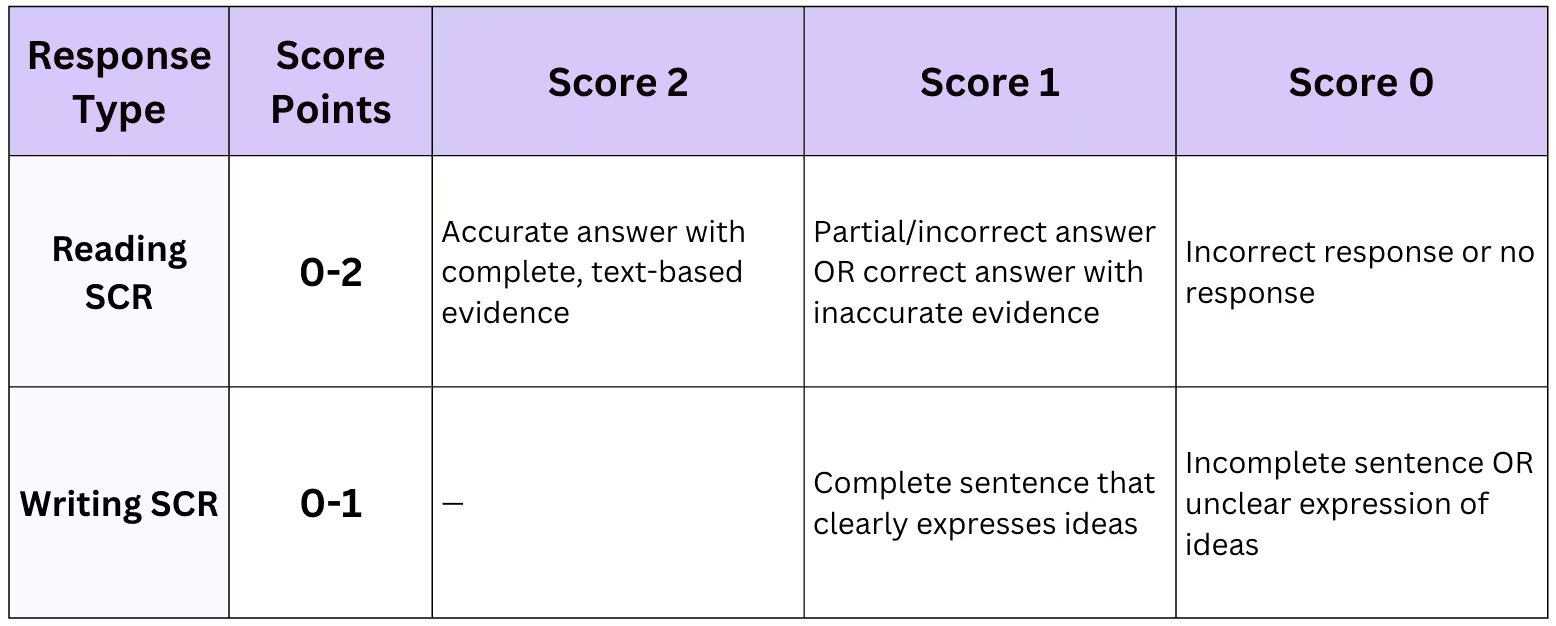STAAR Writing Rubric Overview
The State of Texas Assessments of Academic Readiness (STAAR) Reading Language Arts includes Extended Constructed Response (ECR) essays in grades 3-8 and English I-II, along with Short Constructed Responses (SCRs) across all grade levels.
Texas uses official rubrics from the Texas Education Agency (TEA) for consistent, standards-aligned scoring.

Key Details:
- Grades: 3-8 & English I-II
- Rubric grade bands: 3-5 and 6-English II
- Writing types: Informational; Argumentative/Opinion
- Format: Online by default (paper only for approved exceptions)
- Scoring (ECR): 0-3 Organization and Development of Ideas + 0-2 Conventions = 5 points total.
If Organization and Development of Ideas = 0 → Conventions automatically = 0 - Scoring (SCR): Reading = 2-point (item-specific); Writing = 1-point (generic)
Free AI Grader for STAAR Rubric
We've developed an AI grading platform that allows you to grade an entire class's essays in 2 minutes or less using Texas's official STAAR writing rubrics. Try it out for free below.

Official STAAR Writing Rubrics
Grades 3-5 Rubrics
Grades 6-English II Rubrics
Constructed Response Scoring Guides By Grade (2025)
How to Score Essays Using the STAAR ECR Rubric
Total: 5 points → Organization & Development of Ideas (0–3) + Conventions (0–2).
Rule: If Org/Dev = 0, then Conventions = 0.
Organization & Development of Ideas (0–3)
3 – Clear central idea; purposeful structure (effective intro & conclusion); specific, relevant text evidence (for paired passages: both texts in Grades 6–EII); clear, effective expression.
2 – Central idea present; organization evident but uneven; limited/some irrelevant evidence; basic expression.
1 – Central idea weak/undeveloped; minimal or weak organization; insufficient/mostly irrelevant evidence; ineffective expression.
0 – Severely underdeveloped; no coherent structure; no relevant evidence; unclear/incoherent expression.
Conventions (0–2)
2 – Consistent command of grade-level conventions; errors minor, meaning clear.
1 – Inconsistent command; several errors but generally understandable.
0 – Little/no command; frequent errors impede understanding.
STAAR Writing Scoring Chart

Important STAAR Scoring Rule: If a response receives a score of 0 in Organization and Development of Ideas, it automatically receives 0 in Conventions as well.
This means the essay must demonstrate at least minimal development to earn any points for conventions.
STAAR Writing Rubric Differences by Writing Type
Argumentative/Opinion
• Clear claim/opinion; relevant text evidence to support reasons.
• Grades 8–EII: top responses identify and refute counterarguments.
• Purposeful organization with logical progression.
Informational
• Clear central/controlling idea; accurate text evidence to explain/inform.
• Logical informational structures (e.g., cause/effect, compare/contrast).
Paired-Passage Evidence
• Grades 6–English II: Score 3 requires evidence from both texts; Score 2 allows at least one text.
• Grades 3–5: top responses may cite at least one text (both strengthens the response).
STAAR Short Constructed Response (SCR) Scoring
Short constructed response questions appear across STAAR Reading Language Arts assessments in grades 3-8 and English I-II.
Each SCR is scored using rubrics specific to the question type.

Important note: Reading SCR rubrics are prompt-specific and live inside each grade-level Constructed Response Scoring Guide. There is no single universal SCR rubric PDF—each scoring guide contains the item-specific rubrics for that grade's assessment.
Sample Student Work and Official TEA Resources
Benefits of EssayGrader
Time efficiency & streamlined grading
Simplify and speed up the grading process with intuitive features, allowing you to focus on impactful teaching.
Consistency
& fairness
Ensure fair and accurate grading by eliminating human bias, all while aligning with your curriculum standards.
Actionable insights
& feedback
Receive detailed feedback and growth insights on each essay and seamlessly share them with your students.
Less grading, more teaching
EssayGrader cuts down grading workload so teachers can focus on teaching the craft of writing instead of getting stuck in conventions and mechanics.
Better student outcomes
Students get consistent practice and instant feedback that helps them improve writing skills, build confidence, and prepare for timed assessments like AP exams.
Hours saved every week
Teachers save 5–6 hours a week on grading. That time can be redirected to lesson planning, one-on-one support, or simply reclaiming personal time.
What teachers say about EssayGrader
Frequently Asked Questions About STAAR Writing Rubric
Common questions teachers ask about the STAAR rubric. Contact us if you don't see your question answered below.
The STAAR ECR rubric (Extended Constructed Response) is used to score full essays and uses a 5-point scale that evaluates Organization and Development of Ideas (0-3 points) and Conventions (0-2 points). ECR essays appear on every STAAR Reading Language Arts assessment in grades 3-8 and English I-II, requiring students to compose complete essay responses.
The STAAR SCR rubric (Short Constructed Response) is used for brief answers and varies by subject. Reading SCRs use item-specific 2-point rubrics, while Writing SCRs use a generic 1-point rubric. SCR questions appear across all STAAR RLA grades and test specific reading or writing skills with shorter responses. These rubrics live inside each grade's Constructed Response Scoring Guide rather than as standalone documents.
The Texas Education Agency publishes official STAAR scoring guides annually for each grade level (3-8 and English I-II). These guides include the complete STAAR writing rubric, ECR rubrics, item-specific SCR rubrics, and scored student samples. You can access the most recent scoring guides in the "Constructed Response Scoring Guides" section above, organized by year and grade level.
Both the grades 3-5 and 6-English II STAAR ECR rubrics use the same 5-point scoring system (0-3 Organization and Development of Ideas + 0-2 Conventions). The key differences are:
Grades 6-English II rubrics require:
- Evidence drawn from both texts in paired-passage prompts to earn a score of 3 (score of 2 possible with evidence from at least one text)
- Counterarguments identified and refuted in argumentative essays (grades 8-English II)
- More sophisticated vocabulary and sentence complexity
Grades 3-5 rubrics allow:
- Evidence from at least one text in paired passages to achieve top scores (though using both texts strengthens the response)
- Counterarguments are optional in argumentative essays
- Age-appropriate language and sentence structure expectations
Both rubrics evaluate the same two traits—Organization and Development of Ideas and Conventions—but they differ in what defines a strong response:
STAAR Informational Writing Rubric looks for:
- A clear central idea or thesis that informs or explains
- Evidence that supports factual understanding
- Organizational structures like compare/contrast, cause/effect, or problem/solution
STAAR Argumentative/Opinion Rubric looks for:
- A clear claim or opinion statement that takes a position
- Evidence that persuades and supports the argument
- Counterarguments addressed (grades 8-English II)
- Organizational structures that build a logical case
Teachers should select the rubric that matches the prompt type students received.
Yes, the Texas Education Agency provides official Spanish-language STAAR writing rubrics for grades 3-5. These include both the Argumentative/Opinion and Informational writing rubrics translated into Spanish for use in bilingual and dual-language programs. You can find the Spanish rubrics in the "Official STAAR Writing Rubrics" section above under "Grades 3-5 Rubrics."

















.avif)
.avif)
